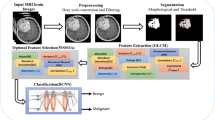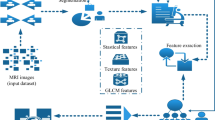Abstract
The unnatural and uncontrolled increase of brain cells is called brain tumors, leading to human health danger. Magnetic resonance imaging (MRI) is widely applied for classifying and detecting brain tumors, due to its better resolution. In general, medical specialists require more details regarding the size, type, and changes in small lesions for effective classification. The timely and exact diagnosis plays a major role in the efficient treatment of patients. Therefore, in this research, an efficient hybrid optimization algorithm is implemented for brain tumor segmentation and classification. The convolutional neural network (CNN) features are extracted to perform a better classification. The classification is performed by considering the extracted features as the input of the deep residual network (DRN), in which the training is performed using the proposed chronological Jaya honey badger algorithm (CJHBA). The proposed CJHBA is the integration of the Jaya algorithm, honey badger algorithm (HBA), and chronological concept. The performance is evaluated using the BRATS 2018 and Figshare datasets, in which the maximum accuracy, sensitivity, and specificity are attained using the BRATS dataset with values 0.9210, 0.9313, and 0.9284, respectively.













Similar content being viewed by others
Data Availability
The data underlying this article are available in BRATS 2018 dataset at https://wiki.cancerimagingarchive.net/pages/viewpage.action?pageId=37224922 and Figshare dataset at https://figshare.com/articles/brain_tumor_dataset/1512427
References
David N. Louis, Arie Perry, Guido Reifenberger, Andreas von Deimling, Dominique Figarella‑Branger, Webster K. Cavenee, Hiroko Ohgaki, Otmar D. Wiestler, Paul Kleihues, and David W. Ellison, The 2016 World Health Organization Classification of Tumors of the Central Nervous System: a summary, Acta Neuropathol, vol. 131, pp. 803–820, 2016.
Jaeyong Kang, Zahid Ullah, and Jeonghwan Gwak, MRI-Based Brain Tumor Classification Using Ensemble of Deep Features and Machine Learning Classifiers, Sensors, vol. 21, no. 6, 2021.
Gopal S. Tandel, Mainak Biswas, Omprakash G. Kakde, Ashish Tiwari, Harman S. Suri, Monica Turk, John R. Laird, Christopher K. Asare, Annabel A. Ankrah, N. N. Khanna, B. K. Madhusudhan, Luca Saba, and Jasjit S. Suri, A Review on a Deep Learning Perspective in Brain Cancer Classification, Cancers, vol. 11, no. 1, 2019.
Ahmad M. Sarhan, Brain Tumor Classification in Magnetic Resonance Images Using Deep Learning and Wavelet Transform, Journal of Biomedical Science and Engineering, vol. 13, no. 6, pp. 102-112, 2020.
Yurong Guan, Muhammad Aamir, Ziaur Rahman, Ammara Ali, Waheed Ahmed Abro, Zaheer Ahmed Dayo, Muhammad Shoaib Bhutta, and Zhihua Hu, A framework for efficient brain tumor classification using MRI images, Mathematical Biosciences and Engineering, vol. 18, no. 5, pp. 5790-5815, 2021.
Francisco Javier Díaz-Pernas, Mario Martínez-Zarzuela, Míriam Antón-Rodríguez, and David González-Ortega, A Deep Learning Approach for Brain Tumor Classification and Segmentation Using a Multiscale Convolutional Neural Network, Healthcare, vol. 9, no. 2, pp. 1-14, 2021.
Parnian Afshar, Konstantinos Plataniotis, and Arash Mohammadi, Capsule Networks for Brain Tumor Classification based on MRI Images and Course Tumor Boundaries, 2018.
Asmita Dixit and Aparajita Nanda, An improved whale optimization algorithm-based radial neural network for multi-grade brain tumor classification, The Visual Computer, 2021.
Jin Liu, Min Li, Jianxin Wang, Fangxiang Wu, Tianming Liu, and Yi Pan, A survey of MRI-based brain tumor segmentation methods, Tsinghua Science and Technology, vol. 19, no. 6, pp. 578-595, 2014.
G.Gokulkumari, Classification of Brain Tumor using Manta Ray Foraging Optimization-based DeepCNN Classifier, Multimedia Research, vol. 3, no. 4, pp. 32-42, 2020.
Xiaoqing Gu, Zongxuan Shen, Jing Xue, Yiqing Fan, and Tongguang Ni, Brain Tumor MR Image Classification Using Convolutional Dictionary Learning With Local Constraint, Front Neuroscience, 2021.
Avinash Gopal, Hybrid classifier: Brain Tumor Classification and Segmentation using Genetic-based Grey Wolf optimization, Multimedia Research, vol. 3, no. 2, pp. 1-10, 2020.
Zeynettin Akkus, Alfiia Galimzianova, Assaf Hoogi, Daniel L. Rubin, and Bradley J. Erickson, Deep Learning for Brain MRI Segmentation: State of the Art and Future Directions, Journal of Digital Imaging, vol. 30, pp. pp. 449–459, 2017.
Isselmou Abd El Kader, Guizhi Xu, Zhang Shuai, Sani Saminu, Imran Javaid, and Isah Salim Ahmad, Differential Deep Convolutional Neural Network Model for Brain Tumor Classification, Brain Sciences, vol. 11, no. 3, 2021.
Heba Mohsen, El-Sayed A. El-Dahshan, El-Sayed M. El-Horbaty, and Abdel-Badeeh M. Salem, Classification using deep learning neural networks for brain tumors, Future Computing and Informatics Journal, vol. 3, no. 1, pp. 68-71, 2018.
Sérgio Pereira, Adriano Pinto, Victor Alves, and Carlos A. Silva, Brain Tumor Segmentation Using Convolutional Neural Networks in MRI Images, IEEE Transactions on Medical Imaging, vol. 35, no. 5, pp. 1240-1251, 2016.
Zhifang Zhan, Jian-Feng Cai, Di Guo, Yunsong Liu, Zhong Chen, and Xiaobo Qu, Fast Multiclass Dictionaries Learning With Geometrical Directions in MRI Reconstruction, IEEE Transactions on Biomedical Engineering, vol. 63, no. 9, pp. 1850-1861, 2016.
Jiang Wang, Yi Yang, Junhua Mao, Zhiheng Huang, Chang Huang, and Wei Xu, CNN-RNN: A Unified Framework for Multi-label Image Classification, In the proceeding of IEEE Conference on Computer Vision and Pattern Recognition (CVPR), 2016.
Jimit Doshi, Guray Erus, Mohamad Habes, and Christos Davatzikos, DeepMRSeg: A convolutional deep neural network for anatomy and abnormality segmentation on MR images, arXiv preprint arXiv:1907.02110, 2019.
Hashim, F.A., Houssein, E.H., Hussain, K., Mabrouk, M.S. and Al-Atabany, W., Honey Badger Algorithm: New metaheuristic algorithm for solving optimization problems, Mathematics and Computers in Simulation, vol.192, pp.84-110, February 2022.
Yao, R., Wang, N., Liu, Z., Chen, P. and Sheng, X., Intrusion detection system in the advanced Metering infrastructure: a cross-layer feature-Fusion CNN-LSTM-Based approach, Sensors, vol.21, no.2, pp.626, January 2021.
BRATS 2018 database, taken from, https://figshare.com/articles/brain_tumor_dataset/1512427, accessed on February 2022.
Rao, R., Jaya: A simple and new optimization algorithm for solving constrained and unconstrained optimization problems, International Journal of Industrial Engineering Computations, vol.7, no.1, pp.19-34, 2016.
Javaria Amin, Muhammad Sharif, Nadia Gul, Mussarat Yasmin, and Shafqat Ali Shad, Brain tumor classification based on DWT fusion of MRI sequences using convolutional neural network, Pattern Recognition Letters, vol. 129, pp. 115–122, 2020.
Wadhah Ayadi, Imen Charfi, Wajdi Elhamzi, and Mohamed Atri, Brain tumor classification based on hybrid approach, The Visual Computer, vol. 38, pp. 107–117, 2022.
Swati, Z.N.K., Zhao, Q., Kabir, M., Ali, F., Ali, Z., Ahmed, S. and Lu, J., Brain tumor classification for MR images using transfer learning and fine-tuning, Computerized Medical Imaging and Graphics, vol.75, pp.34-46, 2019.
Figshare database, taken from, https://wiki.cancerimagingarchive.net/pages/viewpage.action?pageId=37224922, accessed on February 2022.
Chen, Z., Chen, Y., Wu, L., Cheng, S. and Lin, P., Deep residual network based fault detection and diagnosis of photovoltaic arrays using current-voltage curves and ambient conditions, Energy Conversion and Management, vol. 198, pp.111793, October 2019.
Raja, P.S., Brain tumor classification using a hybrid deep autoencoder with Bayesian fuzzy clustering-based segmentation approach, Biocybernetics and Biomedical Engineering, vol.40, no.1, pp.440-453, 2020.
Ghassemi, N., Shoeibi, A. and Rouhani, M., Deep neural network with generative adversarial networks pre-training for brain tumor classification based on MR images, Biomedical Signal Processing and Control, vol.57, pp.101678, 2020.
Mzoughi, H., Njeh, I., Wali, A., Slima, M.B., BenHamida, A., Mhiri, C. and Mahfoudhe, K.B., Deep multi-scale 3D convolutional neural network (CNN) for MRI gliomas brain tumor classification, Journal of Digital Imaging, vol.33, pp.903-915, 2020.
Ottorino Catani, Federico Fusini, Fabio Zanchini, Fabrizio Sergio, Giovanni Cautiero, Jorge Hugo Villafane, and Francesco Langella, Functional outcomes of percutaneous correction of hallux valgus in not symptomatic flatfoot: a case series study, Acta Bio Medica: Atenei Parmensis, vol. 91, no. 3, 2020.
Antonio Bonacaro, Ivan Rubbi, and Dave Sookhoo, The use of wearable devices in preventing hospital readmission and in improving the quality of life of chronic patients in the homecare setting: a narrative literature review, Professioni Infermieristiche, vol. 72, no. 2, pp. 143-151, 2019.
Maicol Carvello, Filippo Zanotti, Ivan Rubbi, Silvia Bacchetti, Giovanna Artioli, and Antonio Bonacaro, Peer-support: a coping strategy for nurses working at the Emergency Ambulance Service, Acta Biomed for Health Professions, vol. 90, no. 3, pp. 29-37, 2019.
Giovanni Parente, Tommaso Gargano, Giovanni Ruggeri, Michela Maffi, Simone D'Antonio, Elisa Sacchet, and Mario Lima, Anastomotic Stricture Definition After Esophageal Atresia Repair: Role of Endoscopic Stricture Index, Journal of surgical research, vol. 257, pp. 572-578, 2021.
Giovanni Parente, Tommaso Gargano, Stefania Pavia, Chiara Cordola, Marzia Vastano, Francesco Baccelli, Giulia Gallotta, Laura Bruni, Adelaide Corvaglia, and Mario Lima, Pyelonephritis in pediatric uropathic patients: Differences from community-acquired ones and therapeutic protocol considerations. A 10-year single-center retrospective study, Children, vol. 8, no. 6, 2021.
Acknowledgements
I would like to express my very great appreciation to the co-authors of this manuscript for their valuable and constructive suggestions during the planning and development of this research work.
Author information
Authors and Affiliations
Contributions
All authors have made substantial contributions to conception and design, revising the manuscript, and the final approval of the version to be published. Also, all authors agreed to be accountable for all aspects of the work in ensuring that questions related to the accuracy or integrity of any part of the work are appropriately investigated and resolved.
Corresponding author
Ethics declarations
Ethical Approval
Not applicable.
Informed Consent
Not applicable.
Conflict of Interest
The authors declare no competing interests.
Additional information
Publisher's Note
Springer Nature remains neutral with regard to jurisdictional claims in published maps and institutional affiliations.
Rights and permissions
Springer Nature or its licensor (e.g. a society or other partner) holds exclusive rights to this article under a publishing agreement with the author(s) or other rightsholder(s); author self-archiving of the accepted manuscript version of this article is solely governed by the terms of such publishing agreement and applicable law.
About this article
Cite this article
Deepa, S., Janet, J., Sumathi, S. et al. Hybrid Optimization Algorithm Enabled Deep Learning Approach Brain Tumor Segmentation and Classification Using MRI. J Digit Imaging 36, 847–868 (2023). https://doi.org/10.1007/s10278-022-00752-2
Received:
Revised:
Accepted:
Published:
Issue Date:
DOI: https://doi.org/10.1007/s10278-022-00752-2




